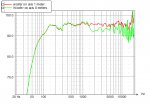Hi,
I've been a long time lurker from back on the old site, but I never had a reason to post (until now).
I work for a theatre company that wants to buy new speakers. We have money for this, but were thinking that by buying used we would be able to take a big step up in quality. We demo'ed Meyer UPM-1P and UPJ-1P speakers and, although there were many qualities we liked about them, we thought the high-end was a little harsh. Our impressions of these were at 95dBA/98dBC measured at 3 feet, so we should be far away from the limiters.
I have heard Meyer in a number of other venues and never wanted to take a step away from the speakers like I felt this time. Has anybody else noticed this? For the record, this was just the speakers; there was no external processing. We do not have high-volume requirements. Most of the time, the rig will be in the upper 80s and low 90s reproducing just voice, but we have always had trouble with intelligibility.
~Jeff
(Pardon me if this better fits JV, I assumed varsity would be more appropriate seeing the brand and semi-pro status of the theatre.)
I've been a long time lurker from back on the old site, but I never had a reason to post (until now).
I work for a theatre company that wants to buy new speakers. We have money for this, but were thinking that by buying used we would be able to take a big step up in quality. We demo'ed Meyer UPM-1P and UPJ-1P speakers and, although there were many qualities we liked about them, we thought the high-end was a little harsh. Our impressions of these were at 95dBA/98dBC measured at 3 feet, so we should be far away from the limiters.
I have heard Meyer in a number of other venues and never wanted to take a step away from the speakers like I felt this time. Has anybody else noticed this? For the record, this was just the speakers; there was no external processing. We do not have high-volume requirements. Most of the time, the rig will be in the upper 80s and low 90s reproducing just voice, but we have always had trouble with intelligibility.
~Jeff
(Pardon me if this better fits JV, I assumed varsity would be more appropriate seeing the brand and semi-pro status of the theatre.)

